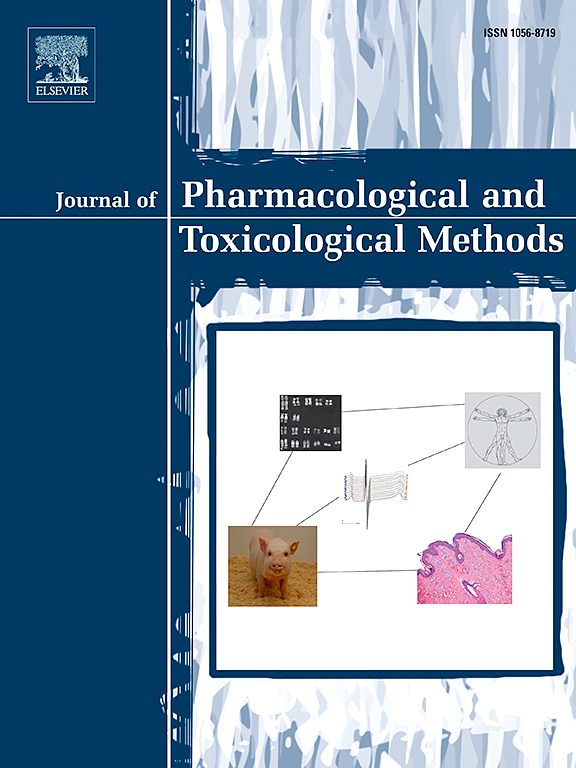Evaluation of the head twitch response in male C57BL/6J mice as a measure of 5-HT2a receptor activation
IF 1.3
4区 医学
Q4 PHARMACOLOGY & PHARMACY
Journal of pharmacological and toxicological methods
Pub Date : 2025-05-01
DOI:10.1016/j.vascn.2025.107622
引用次数: 0
Abstract
The head twitch response (HTR) is a rhythmic paroxysmal rotational head movement that occurs in mice following 5-HT2A receptor activation. This test may be used to evaluate the potential for novel drugs to activate the 5-HT2A receptor, to produce a synergistic effect when co-administered with medications which elevate serotonin levels or antagonize hallucinogenic-like behavior for the purpose of treating aspects of brain disorders, including positive symptoms of Schizophrenia. The HTR was characterized in male C57BL/6J mice using psilocybin (0.5 to 2 mg/kg, IP), psilocin (0.3 to 1.0 mg/kg, IP), LSD (0.05 to 0.2 mg/kg, IP) and DOI (0.25 to 1.0 mg/kg, IP). Immediately following administration, mice were placed into observation chambers and observed continuously for 60 min. The number of head twitches were recorded in 10-min bins. Head twitch was observed in all treatment groups and varied in terms of frequency and time of peak effect. DOI produced an inverted ‘U'-shaped dose response, peaking between 21 and 30 min postdose, with a group total of 85 head twitches (0.5 mg/kg). Psilocybin and psilocin (the pharmacologically active agent of psilocybin) produced a dose-related response, peaking between 11 and 20 and 0 and 10 min postdose, respectively, with a group total of 70 (2 mg/kg) and 55 (1 mg/kg) head twitches, respectively. LSD produced a dose-related response, peaking between 11 and 20 min postdose, with a group total of 63 head twitches (0.2 mg/kg). For the purpose of characterizing attenuation of the HTR, clozapine (atypical antipsychotic) at 1.25 to 5.0 mg/kg, IP or haloperidol (typical antipsychotic) at 0.15 to 0.6 mg/kg, IP, were administered to mice. Thirty minutes later, the hallucinogen DOI (0.5 mg/kg, IP) was administered to induce the HTR. Animals were observed continuously for 30 min from 10 min post-DOI administration. Clozapine (1.25 mg/kg) and haloperidol (0.6 mg/kg) attenuated HTR by 68 and 64 %, respectively, when compared to DOI alone. Clozapine (2.5 and 5 mg/kg) attenuated the HTR, however the animals were highly sedated. These findings validated the HTR test in male C57BL/6J mice.
评估雄性C57BL/6J小鼠的头抽搐反应作为5-HT2a受体激活的测量
头抽搐反应(HTR)是小鼠在5-HT2A受体激活后发生的一种节律性阵发性头部旋转运动。该试验可用于评估激活5-HT2A受体的新药的潜力,当与提高血清素水平或对抗致幻剂样行为的药物共同施用时产生协同效应,以治疗脑部疾病的某些方面,包括精神分裂症的阳性症状。采用裸盖菇素(0.5 ~ 2 mg/kg, IP)、裸盖菇素(0.3 ~ 1.0 mg/kg, IP)、LSD(0.05 ~ 0.2 mg/kg, IP)和DOI(0.25 ~ 1.0 mg/kg, IP)对C57BL/6J雄性小鼠的HTR进行了研究。给药后立即将小鼠置于观察室,连续观察60 min。每10分钟记录一次头抽搐的次数。在所有治疗组中都观察到头抽搐,并且在峰值效应的频率和时间方面有所不同。DOI产生倒“U”形剂量反应,在给药后21至30 min之间达到峰值,一组总共有85次头部抽搐(0.5 mg/kg)。裸盖菇素和裸盖菇素(裸盖菇素的药理活性物质)产生了剂量相关的反应,分别在给药后11 - 20分钟和0 - 10 min之间达到峰值,一组总共有70次(2 mg/kg)和55次(1 mg/kg)头抽搐。LSD产生了与剂量相关的反应,在给药后11到20 分钟达到峰值,一组总共有63次头部抽搐(0.2 mg/kg)。为了表征HTR的衰减,对小鼠给予氯氮平(非典型抗精神病药)1.25至5.0 mg/kg, IP或氟哌啶醇(典型抗精神病药)0.15至0.6 mg/kg, IP。30min后给予致幻剂DOI(0.5 mg/kg, IP)诱导HTR。给药后,动物从10 min开始连续观察30 min。与单独使用DOI相比,氯氮平(1.25 mg/kg)和氟哌啶醇(0.6 mg/kg)分别使HTR减弱68%和64% %。氯氮平(2.5和5 mg/kg)降低了HTR,但动物具有高度镇静作用。这些结果验证了雄性C57BL/6J小鼠的HTR测试。
本文章由计算机程序翻译,如有差异,请以英文原文为准。
求助全文
约1分钟内获得全文
求助全文
来源期刊

Journal of pharmacological and toxicological methods
PHARMACOLOGY & PHARMACY-TOXICOLOGY
CiteScore
3.60
自引率
10.50%
发文量
56
审稿时长
26 days
期刊介绍:
Journal of Pharmacological and Toxicological Methods publishes original articles on current methods of investigation used in pharmacology and toxicology. Pharmacology and toxicology are defined in the broadest sense, referring to actions of drugs and chemicals on all living systems. With its international editorial board and noted contributors, Journal of Pharmacological and Toxicological Methods is the leading journal devoted exclusively to experimental procedures used by pharmacologists and toxicologists.
 求助内容:
求助内容: 应助结果提醒方式:
应助结果提醒方式:


